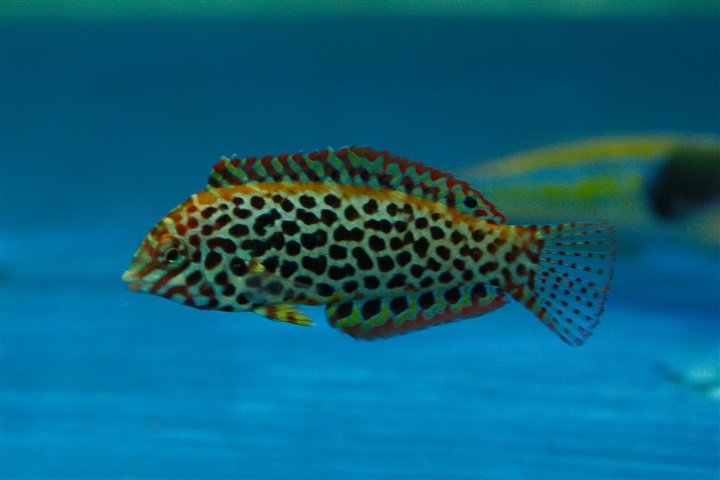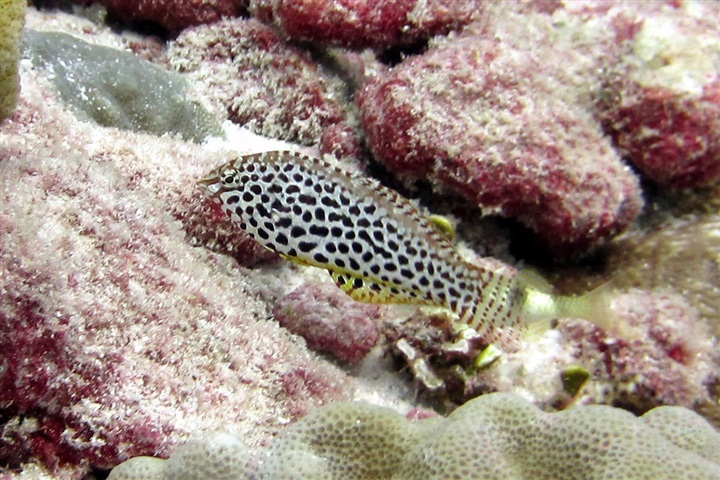Macropharyngodon meleagris


| Latin name | Macropharyngodon meleagris - (Valenciennes, 1839) |
|---|---|
| Local name | Blackspotted wrasse |
| Family | Labridae - Macropharyngodon |
| Origin | East Indian Ocean, Australia, Japan, Indonesia, East Pacific, Central/West Pacific |
| Max length | 15 cm (5.9") |
| Minimum volume |
500 l (132 gal) |
|---|---|
| Hardiness |
Average |
| Suitable for aquarium |
Experience, preparation and extra care required |
| Reef safe |
Always reef safe |
| Aggressiveness | Docile |
| Recommended |
Small crustaceans (Krill, mysis, artemia...) Zooplankton (Cyclops, pods...) |
|---|
It is preferable that this species should be able to find all of its own food in the tank.
It can therefore be very challenging to keep it in an aquarium, as it so easily runs out of food.
This species is very sensitive during transportation and acclimatizing into the aquarium.
This species needs a minimum of 2 inch (5 cm) of sand in the aquarium bottom, so it can dig itself down when afraid or needing to sleep.
This fish requires feeding several times a day, especially when newly added.
When the fish can find its natural food in the aquarium it requires less frequent feeding.
This species is very shy and docile, so one should be careful when keeping it with more aggressive fish.
Several specimen of this species can coexist in the same aquarium, provided they are introduced simultaneously.
This species can change gender from female to male.
When a male is needed, a female changes sex and takes on the role.
Leopard Wrasses have fascinating colours and patterns, but they are not for the novice because of their nutritional and dietary needs.
One must have a well established aquarium where these fish can find their own food in the form of small snails and pods. If there is not enough food they will slowly die, due to malnutrition. This means too, that it is a bad move to keep them with competitors for the same foods, such as Mandarinefish, unless one is absolutely certain that there is sufficient to go around.
One should supplement their diet with various kinds of frozen foods, several times daily.
These Wrasses dig themselves into the sand when feeling threatened or when needing to sleep.
If they are transported in a container without sand, can they be injured in the area around their mouth, this is something which must be checked when selecting fish in the fish store. They have an excellent biological clock, but after transportation it takes a bit of time before it starts working properly again.
One must not introduce Leopard Wrasses into an tank with aggressive fish, as then it will be hard to get them to eat.
Wrasses are nearly always seen in reef aquaria, since many of the species are both attractive and useful in battling a range of unwanted invertebrates like i.e. flatworms, pyramide snails.
These fish live of everything from zooplankton to large crustaceans, sea urchins and the like.
The needs and behaviour of Wrasses vary greatly, so it is vital to familiarize oneself with the specific species before buying one.
| Aquarium trade | Yes |
|---|---|
| Distribution | Indo-Pacific: Cocos-Keeling Islands in the eastern Indian Ocean to western Pacific and islands of Oceania. |
| English common names |
Leopard wrasse Guinea fowl wrasse Reticulated wrasse |
Henry C. Schultz. 2002. The Leopards of the Reef - Reefkeeping Magazine - (English)
Bob Fenner. Leopard Wrasses, the Genus Macropharyngodon; Hardier Than They Used To Be - Wet Web Media - (English)
Terry Siegel. 2003. Leopard Wrasses - Advanced Aquarist - (English)
Bob Fenner. 2011. Leopards for the Reef - Tropical Fish Hoppyist Magazine - (English)
Scott W. Michael. 2009. Wrasses and Parrotfishes (Reef Fishes Series Book 5) - TFH Publications / Microcosm Ltd. - (English)

